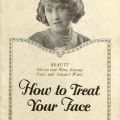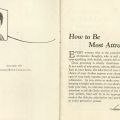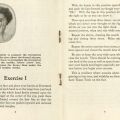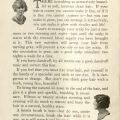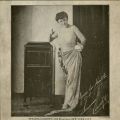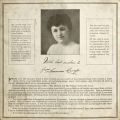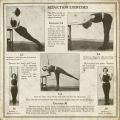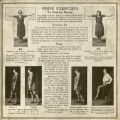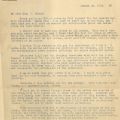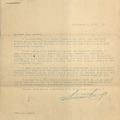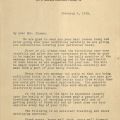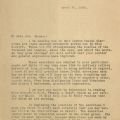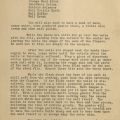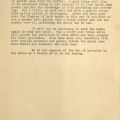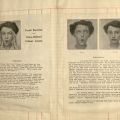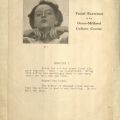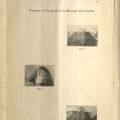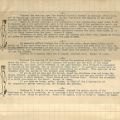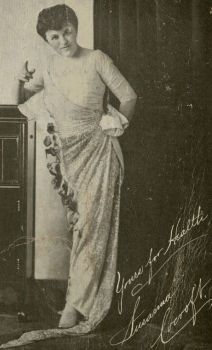 Today you might take a class online, and correspond with a teacher and fellow students through an online learning management system like Canvas. Before the Internet, there were a number of ways that students connected with education, including printed correspondence courses sent through the mail.
Today you might take a class online, and correspond with a teacher and fellow students through an online learning management system like Canvas. Before the Internet, there were a number of ways that students connected with education, including printed correspondence courses sent through the mail.
Correspondence courses served as an early form of distance education, and allowed for the flow of ideas and cultural norms across national boundaries. The Captain Alv Kulstad and George Kulstad Collection in the Old China Hands Archives contains two different correspondence courses sent to Helen Kulstad (neé Nellie Thomas), an American living in Shanghai, China in the early 20th century. These courses provide examples of both distance learning education and behavioral and beauty expectations for American women in the 1920s.
Correspondence courses relied on mail delivery, so that even those in rural or remote areas could enroll. For those who could afford the cost, this broadened the pool of individuals able to participate in education, as it did not require full-time in-person attendance. Modern distance education started with Sir Isaac Pitman’s shorthand course, which taught students a quick, abbreviated way of taking notes. Pitman would send postcards for students to practice on, and then mail back for corrections and feedback. In 1892 the University of Chicago was the first to offer college-level correspondence courses in the United States.
Distance learning targeting women students brought education into the home sphere where 19th century women were already expected to dwell. Anna Eliot Ticknor founded the Society to Encourage Studies at Home in 1873 in order to provide distance education specifically to women. It offered a number of departments of study, including history, natural sciences, art, and French literature. While such courses broadened opportunities for access to knowledge, they were also a way to disseminate uniform cultural ideals and expectations over a wide geographic swath. Student participation in this type of education was limited by their knowledge of the courses' existence, and their ability to pay for and have time to complete the coursework.
Helen Kulstad received culture course correspondence from the Susanna Cocroft and Grace Mildred Culture Courses in the 1920s. The Susanna Cocroft courses, and later the Grace Mildred Culture Courses, were administered out of offices in New York City. These correspondence courses linked beauty to fitness and good health, and had a more practical tone than previous academic correspondence courses targeted at women.
 Susanna Cocroft published a number of books on health and beauty in the early 20th century that cemented her place as a cultural authority on the subject. The titles are not that far off from what you would find displayed in the grocery store check-out line today, like "What to Eat and When" and "Beauty a Duty: The Art of Keeping Young." Cocroft's early work was published by the Chicago-based Physical Culture Extension Society, which promoted women's physical fitness as key to promoting women's sense of self and well-being, and by extension their ability to contribute to society.
Susanna Cocroft published a number of books on health and beauty in the early 20th century that cemented her place as a cultural authority on the subject. The titles are not that far off from what you would find displayed in the grocery store check-out line today, like "What to Eat and When" and "Beauty a Duty: The Art of Keeping Young." Cocroft's early work was published by the Chicago-based Physical Culture Extension Society, which promoted women's physical fitness as key to promoting women's sense of self and well-being, and by extension their ability to contribute to society.
Unlike earlier distance education efforts targeted at women, the lessons in the Kulstad Collection were geared toward physical fitness, rather than increasing knowledge. The Susanna Cocroft booklet How to Treat Your Face encouraged readers to "Look closely at yourself and decide just where you need the most help, and then set out intelligently to enhance your best points and to correct the bad ones." The booklet provided advice on face washing, masks, and facial exercises to enhance beauty. Personalized correspondence that accompanied a book of exercises encouraged culture course students to do certain exercises for weight loss or poise. In addition to printed text and visual instructions, the Susanna Cocroft course also mailed out records with audio instructions on how to do certain exercises tailored to an individual student's needs.
Although Kulstad was located in Shanghai, she was able to connect to contemporary American ideology regarding women and physical fitness through the Susanna Cocroft and Grace-Mildred correspondence courses. In a space where there was potentially an absence of an extensive American female community network to provide guidance on how to act or behave, the print culture of correspondence courses filled that gap through the distribution of cultural knowledge and standards.



